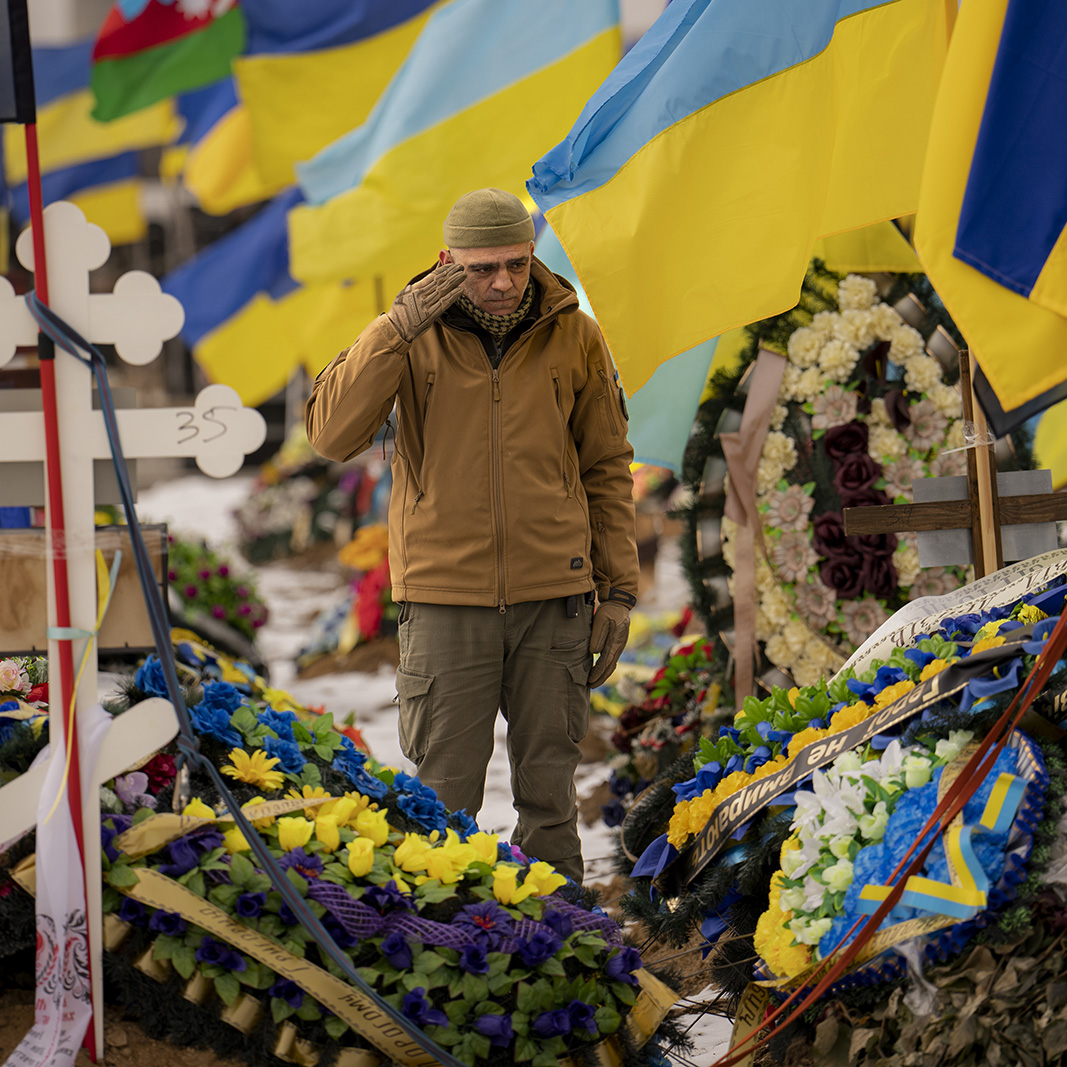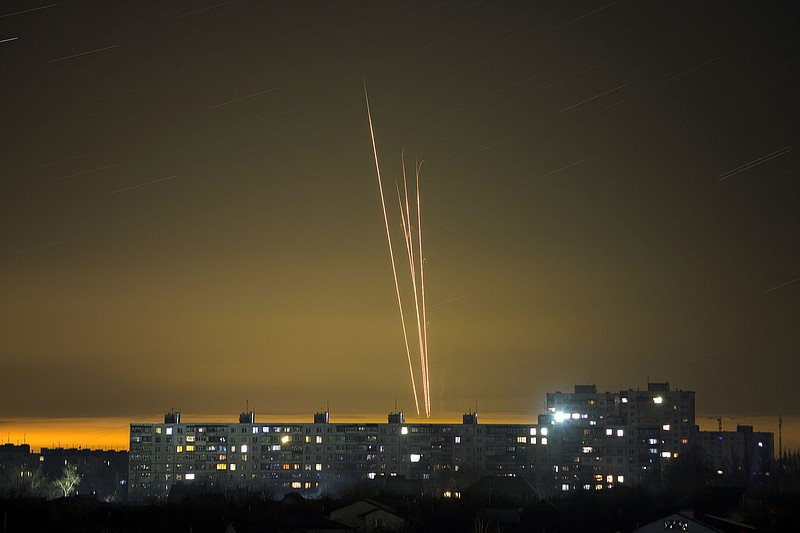KYIV, Ukraine -- Russia has switched its aerial strike tactics to fool Ukraine's air defenses, using decoy missiles without explosive warheads and deploying balloons, a senior Ukrainian official said Thursday.
"The Russians are definitely changing tactics" as the war approaches its one-year anniversary, Mykhailo Podolyak, an adviser to Ukrainian President Volodymyr Zelenskyy, said in an interview with The Associated Press.
The goal of the decoy missiles, Podolyak said, is to overwhelm Ukraine's air defense systems by offering too many targets.
"They want to overload our anti-aircraft system to get an extra chance to hit infrastructure facilities," Podolyak said, adding that Ukraine's air defenses are adapting to the challenge.
In the AP interview, Podolyak also renewed Ukraine's appeals for long-range missiles that would enable it to strike Russian troop concentrations far behind the front lines, and also stressed that "we just don't have enough shells."
He argued that speeding up supplies of weaponry from Western partners would quicken an end to the war and said drawn-out war would favor Russia, not least because its population is more than three times that of Ukraine.
"A protracted war is the slow death of Ukraine," he said. "Russia has enough time. Why? They will live in poverty. They always live like this. They don't need comfort. They can live in a camp. They can live in isolation."
But nearly a year into the Russian invasion, the human, economic and diplomatic costs are proving huge for Moscow. Its military difficulties include a growing shortage of missiles, Ukrainian and Western officials say. It has fired wave upon wave of missiles and killer drones at Ukraine since October, in a sustained and targeted effort to take out power supplies and other essential infrastructure over the winter.
Podolyak said Russia is facing "missile exhaustion" and that shortages are forcing its change in tactics. He said Russia is mixing older Soviet-era missiles with "new missiles that have some value."
Moscow has not acknowledged problems with weapon supplies. But Britain's Defense Ministry said in late November that Russia appeared to be stripping nuclear warheads off old cruise missiles and then firing the missiles as blanks at Ukraine. "Russia almost certainly hopes such missiles will function as decoys and divert Ukrainian air defenses," it said.
Ukraine's Western allies have progressively boosted the country's air defenses in response to Russia's expanded bombardments of the power grid and other targets. The sophisticated Western-supplied systems have helped deny air superiority to Russia's much larger air force and blunted its missile and drone attacks.
The changed Russian tactics -- seen by some as evidence that Moscow is adapting its brute-force war strategy into something more nuanced -- appeared to pay dividends Thursday when Russian forces fired 36 missiles in a two-hour overnight burst. Ukrainian air defense batteries shot down 16 of them -- a lower rate of success than against some previous Russian waves.
Another new feature of Russia's strategy is the use of what Podolyak called "special air balloons." He wouldn't go into detail about their suspected purpose. But they may be intended to possibly confuse or provide intelligence about Ukrainian air defenses.
Oleksiy Danilov, secretary of Ukraine's National Security and Defense Council, said the Russian balloons carried reflectors to mislead air defenses, and indicate that Moscow is "starting to use other methods."
Air Force spokesman Yurii Ihnat said: "The enemy wants our air defense systems to spend ammunition on these balloons, the cost of which is quite small."
Kyiv's military administration said six such balloons were detected floating over the capital on Wednesday. Ukrainian air defenses shot down most of them.
Russia's new use of balloons in Ukraine comes after the Biden administration shot down a China balloon, saying it was equipped to detect and collect intelligence signals.
Russia's latest barrage of cruise and other missiles hit targets in the north, west, south, east and center of the country, Ukrainian officials said.
One of the strikes killed a 79-year-old woman and injured at least seven other people in the eastern city of Pavlohrad, the regional governor said.
Overall, Russian attacks and shelling over the previous 24 hours killed at least seven people, Ukraine's presidential office said Thursday.
'RACE OF LOGISTICS'
Russia and Ukraine are depleting ammunition stocks at a staggering pace in the nearly yearlong war, putting pressure on weapons makers globally to meet demand and forcing Moscow to turn to allies like Iran to bolster supplies.
As the fighting intensifies yet again, with Russia expanding its offensive operations and Ukraine planning for its own counteroffensive in the coming months, the next phase of the war could turn on which side can rearm faster and more effectively, according to Western military officials.
Jens Stoltenberg, secretary-general of the North Atlantic Treaty Organization, said this week that it was now a "race of logistics" between the two armies and their allies. But in a reflection of the sheer volume of destructive power needed just to hold off the Russians, Stoltenberg warned that Ukraine's ammunition expenditure is outpacing Western production.
"This puts our defense industries under strain," he said.
Artillery is thundering at a furious rate across the entire eastern front -- including around Bakhmut, the city in the heart of eastern Ukraine's mineral-rich Donbas region, where the war's longest and perhaps bloodiest battle continues to rage.
Zelenskyy said the fortitude shown by his soldiers to hold their lines will leave Russia weakened for when Ukraine strikes back.
"Everything that the enemy loses in our Donbas, it will not be able to restore," he said in his nightly address Tuesday.
Ukraine is better positioned than it was last summer, when its military warned in late June that it was running out of ammunition as it struggled to hold off a Russian offensive in the east. Then, Ukraine was still largely reliant on Soviet-era artillery and weapons systems.
As Western allies stepped up military support, delivering howitzers and precision missiles that helped Ukraine strike deep behind enemy lines, Ukraine halted Russia's gains and went on the offensive in the northeast and south, scoring some of its biggest gains in the war.
But the intensity of the artillery exchanges is forcing commanders to make difficult decisions about how best to use the stocks they have. On Tuesday, the U.S. defense secretary, Lloyd Austin, said Western nations were pressing for tactical training that could reduce Ukraine's dependence on artillery fire.
While the United States, Ukraine's largest supplier of military equipment, has pledged to continue supporting the country, some experts have raised two separate but related concerns: that the war is eating into U.S. military stockpiles that could take years to replenish and that a slowdown in supplies to Ukraine could give Russia an advantage.
One of the West's biggest areas of concern is 155-mm shells, a key munition in what has become largely a ground-based artillery war. With both Ukrainian and Russian troops firing thousands of howitzer rounds at each other every day, the Pentagon said recently that it would raise its production of artillery shells by 500% within two years so that it could eventually produce 90,000 or more shells a month.
An analysis published last month by the Center for Strategic and International Studies, a Washington-based research institute, highlighted that the amount that Ukrainian forces are using every month along the 600-mile front line would eclipse the higher rate of production. That would require other nations to continue providing large amounts of artillery shells or force Ukraine to reduce its use of them, the analysis said.
"Ukraine will never run out of 155-millimeter ammunition -- there will always be some flowing in -- but artillery units might have to ration shells and fire at only the highest priority targets," wrote Mark Cancian, a senior adviser at the center. "This would have an adverse battlefield effect."
Russia, according to Western military analysts, has also severely depleted its conventional weapons stockpile.
Moscow is increasing its military spending, racing to empty its warehouses of ammunition, working to make old equipment ready for combat and turning to its few military allies, like Iran and North Korea, to strengthen its arsenal, according to an annual threat assessment Norway's intelligence service published this week.
Russia has used up three-quarters of its modern surface-to-surface missiles in Ukraine, and reserves of older equipment will take time to get to the battlefield, the report found.
"Much of this will now be retrieved, but it will take several months to make the material ready for operational efforts," the assessment said.
Information for this article was contributed by John Leicester and Hanna Arhirova of The Associated Press and by Marc Santora and Shashank Bengali of The New York Times.
 A Ukrainian soldier stands between the graves of soldiers and salutes Thursday in Kharkiv, Ukraine, during the funeral for Hennadii Kovshyk, who was killed on the front lines in the eastern part of the country. Russia again pummeled Ukraine with a barrage of missiles Thursday, while Ukrainian authorities said Russia has changed tactics to fool air defenses, using decoy missiles and balloons. (AP/Vadim Ghirda)
A Ukrainian soldier stands between the graves of soldiers and salutes Thursday in Kharkiv, Ukraine, during the funeral for Hennadii Kovshyk, who was killed on the front lines in the eastern part of the country. Russia again pummeled Ukraine with a barrage of missiles Thursday, while Ukrainian authorities said Russia has changed tactics to fool air defenses, using decoy missiles and balloons. (AP/Vadim Ghirda)